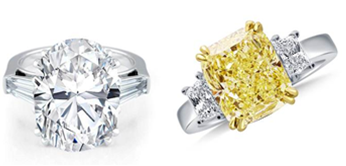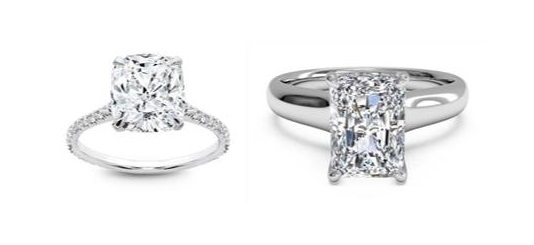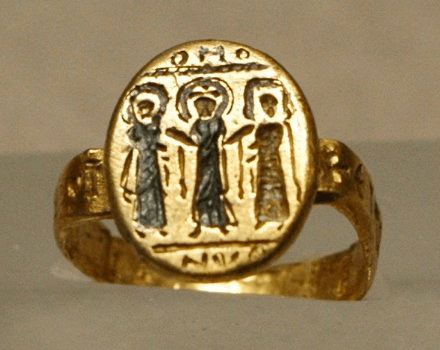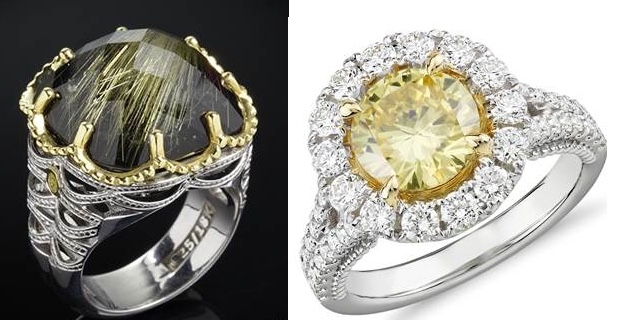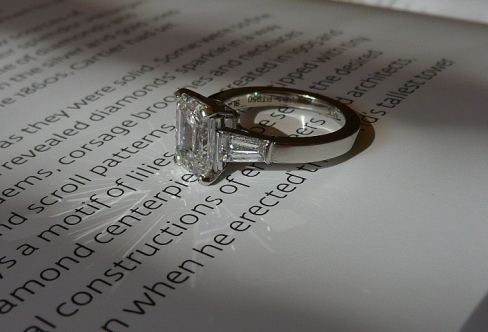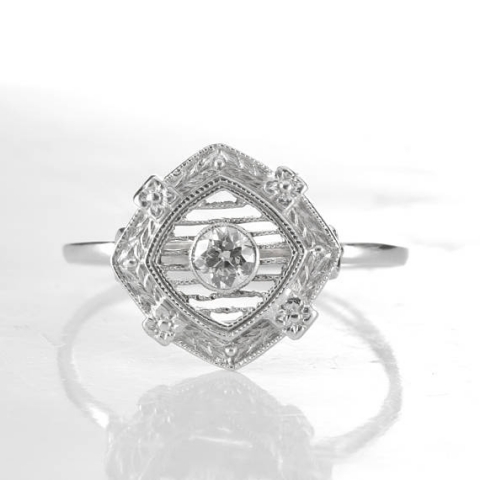Enthusiasts

Portland Jewelry Symposium Focuses On 3D Printing And Other Technologies
Jewelry News Network |
| Peter Smith delivering the keynote at the Portland Jewelry Symposium. Photo by Lena Knofler |
The Portland Jewelry Symposium celebrated its 10th anniversary but there was no time to wax nostalgic at the most recent gathering. Instead it was time to focus on the future of the industry. This future consists of the use of technology in general and more specifically that continued growth of 3D printing technology.
“It just seemed like so much evolution is going on so maybe we should just focus on the future so everybody can sit here for a day-and-a-half and think about the next 10, 15 years for their businesses,” said Teresa Frye, who founded the symposium.
 |
| Teresa Frye, founder of the Portland Jewelry Symposium. Photo by Lena Knofler |
Frye, owner and president of TechForm Advanced Casting Technology, a jewelry manufacturer, said her business is 95% digital. She is dependent on designers who create the pieces that she manufactures. Because of this she said she is most interested in how designers will adapt to new ways of creating jewelry without losing the human aspect of the artistry and design.
“It’s so easy to look at the robots and say that has nothing to do with my craft, it’s so cold and sterile. Yet we can’t avoid it,” she said. “It’s crucial to our survival that we pick the elements of technology that are going to help us to not just survive but to stay at the top of our game and I think that’s the challenge for the industry because we really are so traditional.”
| One of several 3D printers on display. Photo by Lena Knofler |
She says there is no one answer, designers, manufacturers and retailers will have to adapt various elements of technology in ways that will enhance their businesses.
“Our customers value the handcrafted nature of what we do, yet we’re going to have to give up some of that. All the top brands know that they have to select the elements of technology that is going to help them to remain competitive yet they can’t lose their soul in the process. And I still don’t know what the answer because it really lies with the designers as far as the aesthetics of what we’re creating and how do we not lose that in the process.”
This year’s symposium, with the theme “Future Think: Innovate, Create, Thrive,” was held October 1 and 2 at the Sentinel Hotel in downtown Portland, Ore. Approximately 150 independent retailers, manufacturers, designers and others in the jewelry trade attended this year. The attendance was a new record for the symposium. In addition, it has grown from a regional gathering in the northwest United States to a national event. Frye said one of her challenges is to manage this growth while maintaining its intimate, informal and friendly atmosphere.
| 3D Printer models. Photo by Lena Knofler |
3D printing was the hot topic this year and they were the top item on display among the vendors at the event. The technology is being used regularly to produce jewelry molds that are used for casting. Costs of the machines have dropped significantly over the years and they are smaller and easier to use. Their easy entry point has opened up jewelry design to a broader group of people. For example, retailers can now create custom designs for their customers.
The vast majority of 3D printing is being used to create resin models for casting; the same wax models are used. However, the newest generation of 3D printers can now print jewels using precious metals. As one vendor told me the process hasn’t been perfected yet and isn’t a viable replacement for current uses.
But it doesn’t take an expert to know that the technology will get better. Frye, who is well adept with technology and how it is used in manufacturing environments, sees this as well. She says it brings questions on how it may change jewelry design.
“I’m thinking about this next evolution of 3D printing,” Frye said. “Is jewelry going to start looking all the same because we’re letting the technology dictate the designs? That’s the challenge for the industry and I fully expect there will be many designers who are going to overcome that challenge but there may be inherent limitations with the technology. There is probably going to be a multitude of solutions and what we’re trying to do here is to get that conversation going. We have the experts here talking about what’s out there and then we have the networking with real world jewelers who will challenge these technologies. That’s when you have the really interesting conversations.”
 |
| Kevin Abernathy discussing manufacturing technology. Photo by Lena Knofler |
Kevin Abernathy of BIS Ventures, in his presentation on trends in digital manufacturing, said that 3D metal printing is the next big thing and that artificial intelligence, robotics, cloud computing and other technologies are already commonplace in the world’s largest companies and will soon be commonplace in the jewelry industry.
Abernathy, whose company consults with jewelry manufacturers on their automated and digital technology, said he was an early adapter of 3D printing and computer numerical control (computers automation of machine tools). Because of these technologies, he said “vendors can help you navigate the minutiae of the design in your mind.”
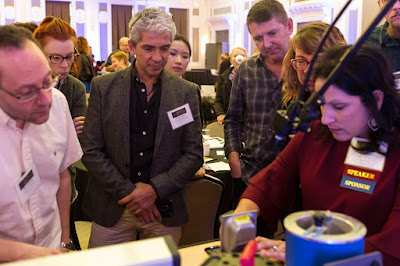 |
| Bench demonstrations. Photo by Lena Knofler |
Abernathy assured those in audience that although these technologies will continue to grow, there is no need to be fearful of losing your job.
“At the end of the day it takes a human, an artist putting that love into a piece of jewelry,” he said. “No machine will ever replace that and no robot will ever do it.”
The keynote address for the symposium was delivered by Peter Smith, jewelry industry consultant and author, who discussed the future of traditional jewelry retail, which he says, is actually brighter than it is being portrayed.
“This fear that somehow we’re losing business to online is just not based in reality,” he told the audience.
 |
| Photo by Lena Knofler |
Instead, he argues what is happening is a transformation of the retail business combining the bricks-and-mortar experience with the convenience of eCommerce. He stresses that it’s retail store that will continue to drive the business.
In most cases, he says, retailers who are losing customers are doing so because they are not providing a high-quality store experience. He said the landscape of the retail industry can be broken down to convenience and price sensitive stores, such as Costco and Wal-Mart; and stores that focus on experience, such as Apple, Starbucks and Tiffany & Co.
Jewelry retailers cannot compete with price so they have to create stores that provide a better experience for their customers. It includes revaluating everything about the store, from the lighting to the music to the scent (which can be purchased) in a way that creates a story about the retail experience they want to deliver.
 |
| Tools of the trade. Photo by Lena Knofler |
Smith also encouraged retailers to streamline their product offerings and focus on what sells and to build eCommerce websites in order to create a well-rounded retail experience.
Sherris Cottier Shank, an award-winning gem artist and master gem carver, had a bit of warning for those jumping into technology head first. She challenged retailers and others in the jewelry industry to think “beyond mainstream” when specifying jewelry.
“All of this automation is really great but remember there are other people out there beyond mainstream,” she said. “Take the time to talk to them and find out what they like.”
Shank, calls herself an “odd duck” in the jewelry industry because what she like in gemstone jewelry is rarely displayed in stores.
“If I were to walk in most jewelry stores today I would turn around and leave. Most jewelry stores would have nothing that interests me,” she said. “There are others like me and I know this because they contact me out of the blue.”
She began her career as a bench jeweler but discovered that she loved the art of gemstone carving. A self-described “girl who plays around in the dirt,” she sometimes goes to the mines to select her gems. She said dealers have mixed reactions when selling to her.
“I’m very careful when I select rough and the sellers either love me or hate me. They usually give me a pad and let me select my own (stones),” she said.
Shank, known for a handful of signature of carvings, has received numerous awards. Several of her pieces are on display in museums, including National Gem & Mineral Collections of the Smithsonian and the Boston Museum of Fine Arts. She also works with exceptional jewelry artists who mount her gems into jewels.
Please join me on the Jewelry News Network Facebook Page, on Twitter @JewelryNewsNet, the Forbes website and on Instagram @JewelryNewsNetwork


